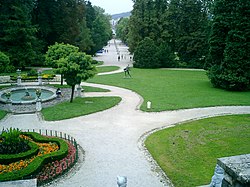Utente:.snoopy./Sandbox
| Parco Tivoli | |
|---|---|
 | |
| Ubicazione | |
| Stato | |
| Località | Lubiana |
| Caratteristiche | |
| Tipo | Parco urbano |
| Inaugurazione | 1813 |

Parco Tivoli (in sloveno Mestni park Tivoli) è il più grande parco di Lubiana la capitale della Slovenia. Si trova nella zona nord della città tra il distretto centro il Distretto Šiška il Distretto Vič e Distretto Rožnik. Molti sono i luoghi di interesse presenti all'interno del parco.
Attrazioni
Architettura
Castello di Tivoli
Tivoli Castle is a mansion and is the terminus of the Jakopič Promenade. Built in the 17th century atop the ruins of a previous Renaissance-period castle, the mansion was initially owned by the Jesuits. In the middle of the 19th century, it was renovated by Marshal Joseph Radetzky (1766–1858) in the Neoclassical style, giving it its present appearance. In 1864, the Austrian sculptor Anton Dominik Fernkorn (1813–1878) created four cast iron dogs that stand in front of the castle. Because the dogs do not have tongues, it has been falsely rumoured that Fernkorn committed suicide by shooting himself due to this mistake. An alpine-style building called the Švicarija ("Swissery", formerly the Hotel Tivoli) stands behind the mansion. The Jesenko nature trail leads past it.
Cekin Mansion
Cekin Mansion is a mansion on the northern edge of Tivoli Park. It houses the Museum of Contemporary History of Slovenia (Muzej novejše zgodovine Slovenije). The mansion was built in 1720, commissioned by Leopold Lamberg and based on plans by the Viennese Baroque architect Fischer von Erlach. Since 1951, it has housed the national museum of contemporary history.
Tivoli Hall
Tivoli Hall is a complex of two multipurpose indoor sport arenas next to the Cekin Mansion. The complex, based on plans by the architect Marjan Božič and the engineer Stanko Bloudek, was opened in 1965. The larger ice hockey arena has a seating capacity of 7,000 people. When configured to host basketball games, the capacity is adjusted to 6,000. The smaller basketball hall has a seating capacity of 4,500 people. This hall hosted home games of the professional basketball team KK Union Olimpija until 2011, while the larger one is the home of HDD Olimpija Ljubljana professional ice hockey club.
Lago Tivoli
At the southwestern end of Tivoli Park is located Tivoli Pond (Template:Lang-sl). The pond is shaped like a rectangle and is shallow with a small volume. In 2011, it was thoroughly renovated. It has been used for recreation, fishing, and as a flood-control reservoir. It has served as a theme of visual artists and musicians. There is a small bronze plastic named Ribe ("Fish") in the pond. It is a depiction of two vertically standing fish, created in 1935 by the expressionist sculptor France Kralj and erected in 1994. On a lawn beside the pond, an open-air library operates in warm weather and a workshop on recycling books and other printed matter, called "The Read Ones." During winter, the library moves into the nearby greenhouse.
Greenhouse and rose garden
A greenhouse with tropical plants, operated by the Ljubljana Botanical Gardens, stands near the northwestern end of the pond. Next to the greenhouse, there is a rose garden. It was created from 1993 to 1994 and renovated in 2007. Over 160 types of roses, including the first Slovenian cultivar, "Prešeren", were added in 2010.
Sculptures
Near the northern end of the pond, at the top of a staircase leading towards Tivoli Castle, stands a bronze sculpture by Zdenko Kalin, named Pastirček ("Shepherd") or Deček s piščalko ("Boy with a Whistle"). It was created in 1942 and erected 1 May 1946. It is a bucolic full-length statue of a marching boy with a whistle and represents one of the peaks of Slovene figurative art.
In 2000, the Bosnian sculptor Slobodan Pejić transformed a 300-year-old oak tree that fell in a storm into a sculpture named Sožitje ("Coexistence"). With the act, he proposed the beginning of a sculpture garden in the park. The sculpture is a rare combination of oak and bronze. It is 4 metri (13 ft) high and it has been grown over by moss and by lichen. The wood embraces a bronze part named Čisto srce ("Pure Heart").
In September 2004, on the occasion of the centenary of his birth, a sitting statue of the poet, writer, and translator Edvard Kocbek was ceremonially unveiled in the immediate vicinity of the pond on its southern side. It is a bronze statue by the sculptor Boštjan Drinovec. The poet sits on a bank and looks at his 30 cm (12 in) double on a handhold of the bank.
History
Tivoli Park was laid out upon the plans by the engineer Jean Blanchard in 1813, when Ljubljana was the capital of the French Illyrian Provinces. He joined two existing parks, around Tivoli Castle (at that time called Podturn Manor) and around Cekin Mansion, and linked them to the Ljubljana downtown. The park was named in the second half of the 19th century after a summer residence of the Casino Society with an amusement park, a pub and a cafe, which was opened in 1835 next to Podturn Manor.
The pond was excavated in 1880. It was later used for boating and ice skating, and for fishing. A tree nursery was established in the park by the city municipality in 1894. It was led by the Czech gardener Vaclav Hejnic, who was the first professional gardener in Tivoli, and who arranged parts of the park in the 1920s.